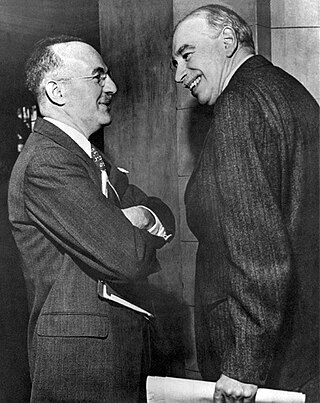Related Research Articles
The General Agreement on Tariffs and Trade (GATT) is a legal agreement between many countries, whose overall purpose was to promote international trade by reducing or eliminating trade barriers such as tariffs or quotas. According to its preamble, its purpose was the "substantial reduction of tariffs and other trade barriers and the elimination of preferences, on a reciprocal and mutually advantageous basis."

The World Trade Organization (WTO) is an intergovernmental organization headquartered in Geneva, Switzerland that regulates and facilitates international trade. Governments use the organization to establish, revise, and enforce the rules that govern international trade in cooperation with the United Nations System. The WTO is the world's largest international economic organization, with 164 member states representing over 98% of global trade and global GDP.

The Reciprocal Tariff Act provided for the negotiation of tariff agreements between the United States and separate nations, particularly Latin American countries. The Act served as an institutional reform intended to authorize the president to negotiate with foreign nations to reduce tariffs in return for reciprocal reductions in tariffs in the United States up to 50%. It resulted in a reduction of duties. This was the policy of the low tariff Democrats in response to the high tariff Republican program which produced the Smoot–Hawley tariff of 1930 that raised rates, and sharply reduced international trade. The Reciprocal Tariff Act was promoted heavily by Secretary of State Cordell Hull.
The Uruguay Round was the 8th round of multilateral trade negotiations (MTN) conducted within the framework of the General Agreement on Tariffs and Trade (GATT), spanning from 1986 to 1993 and embracing 123 countries as "contracting parties". The Round led to the creation of the World Trade Organization, with GATT remaining as an integral part of the WTO agreements. The broad mandate of the Round had been to extend GATT trade rules to areas previously exempted as too difficult to liberalize and increasingly important new areas previously not included. The Round came into effect in 1995 with deadlines ending in 2000 under the administrative direction of the newly created World Trade Organization (WTO).
The Geneva Round was the fourth session of General Agreement on Tariffs and Trade (GATT) multilateral trade negotiations in Geneva, Switzerland. It started in 1955 and lasted until May 1956. Twenty-six countries took part in the round. $2.5 billion in tariffs were eliminated or reduced.
The Kennedy Round was the sixth session of General Agreement on Tariffs and Trade (GATT) multilateral trade negotiations held between 1964 and 1967 in Geneva, Switzerland. Congressional passage of the U.S. Trade Expansion Act in 1962 authorized the White House to conduct mutual tariff negotiations, ultimately leading to the Kennedy Round. Participation greatly increased over previous rounds. Sixty-six nations, representing 80% of world trade, attended the official opening on May 4, 1964, at the Palais des Nations. Despite several disagreements over details, the director general announced the round's success on May 15, 1967, and the final agreement was signed on June 30, 1967—the last day permitted under the Trade Expansion Act. The round was named after U.S. President John F. Kennedy, who was assassinated six months before the opening negotiations.
The International Trade Organization (ITO) was the proposed name for an international institution for the regulation of trade.

The Trade Act of 1974 was passed to help industry in the United States become more competitive or phase workers into other industries or occupations.
This is a timeline of the World Trade Organization (WTO).
The Torquay Round was a multi-year multilateral trade negotiation (MTN) between nation-states that were parties to the GATT. This third round occurred in Torquay, England in 1951. Thirty-eight countries took part in the round. 8,700 tariff concessions were made totalling the remaining amount of tariffs to ¾ of the tariffs which were in effect in 1948. The contemporaneous rejection by the U.S. of the Havana Charter signified the establishment of the GATT as a governing world body.
The Ministerial Conference is the top decision making body of the World Trade Organization (WTO). There have been twelve ministerial conferences from 1996 to 2022, usually every two years.
An eco-tariff, also known as an environmental tariff or carbon tariff, is a trade barrier erected for the purpose of reducing pollution and improving the environment. These trade barriers may take the form of import or export taxes on products that have a large carbon footprint or are imported from countries with lax environmental regulations. The EU Carbon Border Adjustment Mechanism is a carbon tariff.
The term multilateral trade negotiations (MTN) initially applied to negotiations between General Agreement on Tariffs and Trade (GATT) member nations conducted under the auspices of the GATT and aimed at reducing tariff and nontariff trade barriers. In 1995 the World Trade Organization (WTO) replaced the GATT as the administrative body. A current round of multilateral trade negotiations was conducted in the Doha Development Agenda round.
The spaghetti bowl effect is the multiplication of free trade agreements (FTAs), supplanting multilateral World Trade Organization negotiations as an alternative path toward globalization. The term was first used by Jagdish Bhagwati in 1995 in the paper: “US Trade policy: The infatuation with free trade agreements”, where he openly criticized FTAs as being paradoxically counter-productive in promoting freer and more opened global trades. According to Bhagwati, too many crisscrossing FTAs would allow countries to adopt discriminatory trade policies and reduce the economic benefits of trade.
Afghanistan received membership to the World Trade Organization (WTO) at the 10th WTO Ministerial Conference in Nairobi, Kenya, December 17, 2015. Afghanistan is 164th in the world and 36th among the less-developed countries that have received WTO membership.
The European Union's (EU) Common Commercial Policy, or EU Trade Policy, is the policy whereby EU Member States delegate authority to the European Commission to negotiate their external trade relations, with the aim of increasing trade amongst themselves and their bargaining power vis-à-vis the rest of the world. The Common Commercial Policy is logically necessitated by the existence of the Customs Union, which in turn is also the foundation upon which the Single Market and Monetary Union were later established.

The World Trade Organization (WTO) is an intergovernmental organization which regulates international trade. The WTO officially commenced on 1 January 1995 under the Marrakesh Agreement, signed by 123 nations on 15 April 1994, replacing the General Agreement on Tariffs and Trade (GATT), which commenced in 1948. The WTO deals with regulation of trade between participating countries by providing a framework for negotiating trade agreements and a dispute resolution process aimed at enforcing participants' adherence to WTO agreements, which is signed by representatives of member governments and ratified by their parliaments. Most of the issues that the WTO focuses on derive from previous trade negotiations, especially from the Uruguay Round (1986–1994).

Joseph Francois is a professor of international economics at the University of Bern, where he has taught since 2013. Since 2015, he is also the Managing Director of the World Trade Institute. He is co-director of the European Trade Study Group, which he co-founded in 1999. He is a research fellow of the Centre for Economic Policy Research (CEPR) and an at-large board member of the Global Trade Analysis Project (GTAP).
The Dillon Round was a multi-year multilateral trade negotiation (MTN) between 26 nation-states that were parties to the GATT. The fifth round in the GATT occurred in Geneva and lasted from May 1959 through July 1962. The talks were named after U.S. Treasury Secretary and former Under Secretary of State, Douglas Dillon, who first proposed the talks. Along with reducing over $4.9 billion in tariffs with about 4,400 item-by-item cuts, it also yielded discussion relating to the creation of the European Economic Community (EEC).
The Annecy Round was a multi-year multilateral trade negotiation (MTN) between 26 nation-states that were parties to the GATT. This second round took place in 1949 in Annecy, France. 34 countries took part in the round. The main focus of the talks was more tariff reductions, around 5,000 in total.
References
- ↑ Gerber, James (2020). International Economics, 8e (Eighth ed.). 221 River Street, Hoboken, NJ 07030: Pearson Education, Inc. p. 23. ISBN 9780136892410 . Retrieved 4 February 2024.
{{cite book}}: CS1 maint: location (link) - ↑ Deardorff, Alan V.; Stern, Robert M. (1983). "Economic Effects of the Tokyo Round". Southern Economic Journal. 49 (3): 605. doi:10.2307/1058704. JSTOR 1058704.
- ↑ Letiche, John M. (1982). "The Tokyo Round of multilateral trade negotiations (1973–79)". International Economics Policies and their Theoretical Foundations. pp. 413–439. doi:10.1016/B978-0-12-444280-1.50026-4. ISBN 9780124442801.